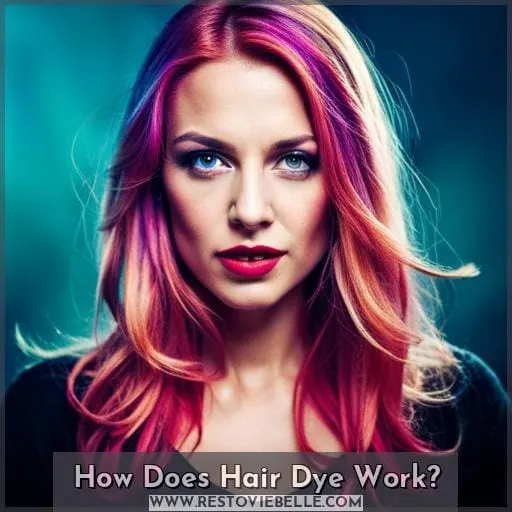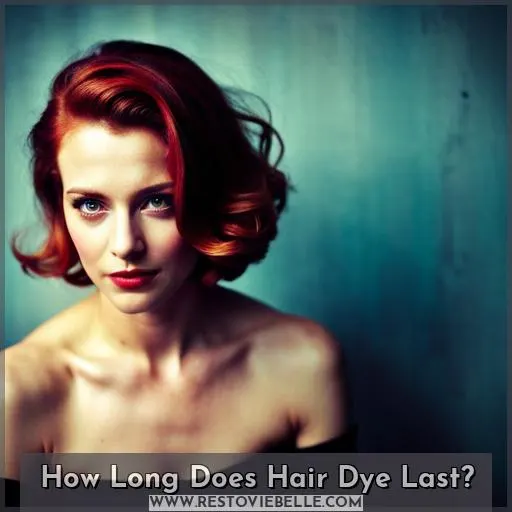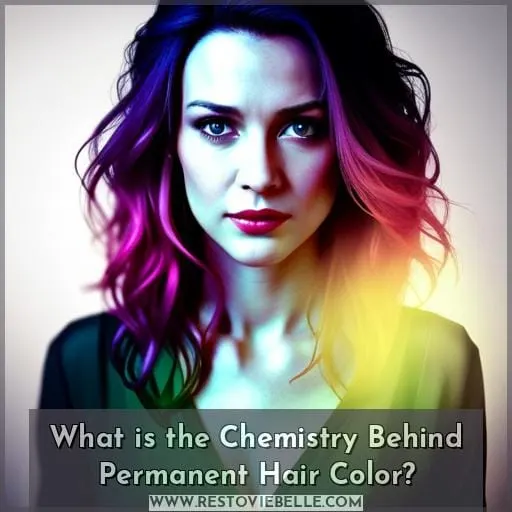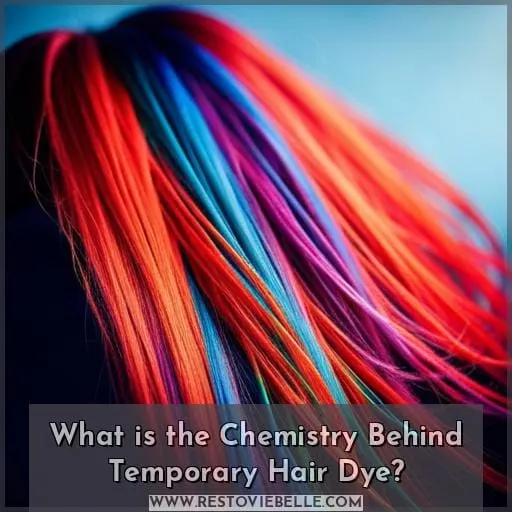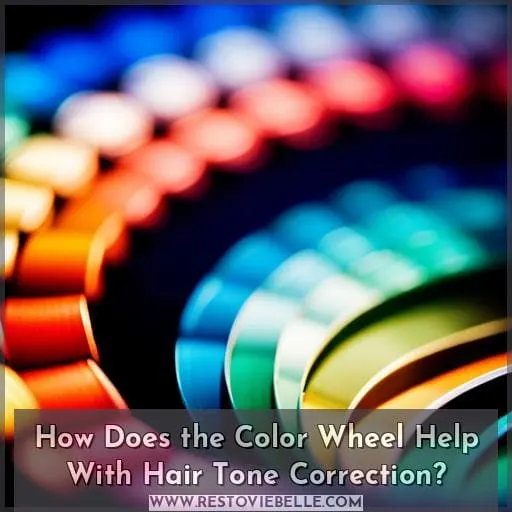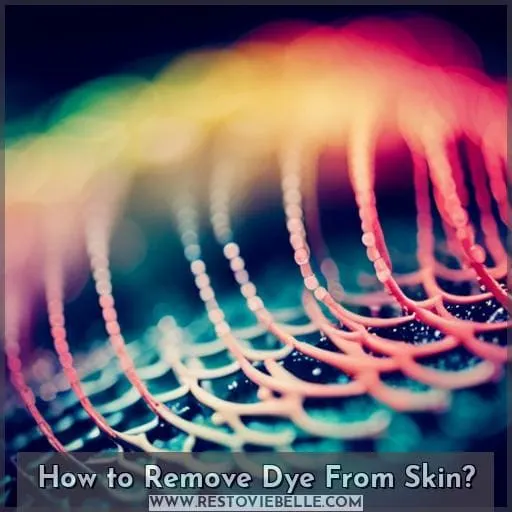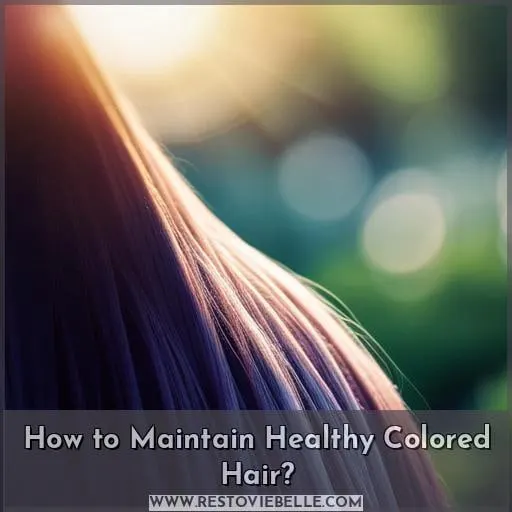This site is supported by our readers. We may earn a commission, at no cost to you, if you purchase through links.
 We’ve all been there: you want to switch up your look, but the idea of a do-it-yourself hair dye job is terrifying. It’s not easy to master the art of at-home coloring without ending up with an orange disaster on your head! But if you understand how hair dye works and have expert tips from colorists in your back pocket, it doesn’t matter whether you’re a beginner or seasoned pro.
We’ve all been there: you want to switch up your look, but the idea of a do-it-yourself hair dye job is terrifying. It’s not easy to master the art of at-home coloring without ending up with an orange disaster on your head! But if you understand how hair dye works and have expert tips from colorists in your back pocket, it doesn’t matter whether you’re a beginner or seasoned pro.
So let’s dive into this chemistry lesson and explore exactly how hair dye works. From permanent dyes to henna treatments, we’ll explain everything about each type of hair color available out there. This way, when it comes time for touchups (or new looks!), you won’t be left stumped by what kind of product is right for achieving stunning results.
Table Of Contents
- Key Takeaways
- How Does Hair Dye Work?
- How Long Does Hair Dye Last?
- What is the Chemistry Behind Permanent Hair Color?
- What is the Chemistry Behind Semi-permanent Hair Dye?
- What is the Chemistry Behind Temporary Hair Dye?
- How Does the Color Wheel Help With Hair Tone Correction?
- Expert Tips From Professional Colorists
- How to Remove Dye From Skin?
- How to Maintain Healthy Colored Hair?
- How to Choose the Right Hair Color for Blondes and Brunettes?
- Conclusion
Key Takeaways
- Permanent hair dye penetrates the cuticles and covers gray with the help of ammonia and peroxide.
- Semi-permanent hair dye provides vibrant color that fades gently over time and does not penetrate the cuticles.
- Temporary hair dye offers vibrant colors for up to 8 washes without penetrating the cuticles.
- Henna dye is a natural, plant-based option that comes in different shades and offers deep conditioning benefits.
How Does Hair Dye Work?
Are you curious about how hair dye works? Permanent, semi-permanent, temporary, and henna dyes all contain different ingredients that react with your hair in various ways. Understanding the chemistry of each type can help you choose a dye that best suits your needs.
Permanent Hair Dye
You can achieve long-lasting results with permanent hair dye, which penetrates the cuticles and reacts with melanin to cover gray hairs. Hair dye chemistry involves chemicals that affect color vibrancy; ammonia is used to open up the strands, and peroxide helps cover gray.
Deep conditioning treatments are recommended for weakened hair as a result of using this type of dye. It’s important to follow best practices for coloring your hair at home, such as using quality products, understanding the right timing, proper lifting techniques for toning correction, and following post-color care routines like nourishing masks and trims.
Semi-permanent Hair Dye
Experimenting with semi-permanent dye can deliver a vibrant and lasting look for up to 28 washes. Semi-permanent color has its benefits, like vibrant shades that don’t require lifting or pre-lightening the hair before application.
Its subtle fading over time is also much gentler on the hair’s structure than other dyes, as it doesn’t penetrate into the cuticle layer of your strands like ammonia and peroxide do in permanent colors.
The chemistry behind this process involves pigment molecules attaching themselves to specific sites within your hair shaft during deposition, which helps preserve vibrancy without damaging it too much! Application tips depend on what kind of shade you choose.
With proper care and maintenance through deep conditioners post-treatment, semi-permanent color longevity can be prolonged while still allowing freedom to experiment with different looks over time.
Temporary Hair Dye
Try temporary dyes for vibrant colors that last up to 8 washes! Temporary hair dye is a great way to experiment and get creative with color without committing long-term. It lacks the harsh chemicals of permanent or semi-permanent dyes, making it gentler on your strands while still providing beautiful results.
The underlying pigments are more effective than semi-permanent, giving you bright hues that won’t fade quickly like demi-permanent shades can. But keep in mind: these colors aren’t meant to stay forever – they’ll wash out eventually and require some upkeep if you want them to look their best.
Be sure to use proper removal techniques when ready for a change; there’s no need to rush through this process since the safety risks associated are much lower than other types of coloring treatments!
Henna Hair Dye
Discover a whole new world of vibrant color with henna hair dye! This natural, plant-based dye offers numerous benefits and is becoming more popular for at-home coloring. Henna comes in different shades, from red to brown, depending on the mix of ingredients used.
When applying, it’s important to follow all instructions properly in order to achieve desired results.
Aftercare is also essential as henna can dry out strands if not moisturized correctly.
How Long Does Hair Dye Last?
Understanding how long your hair dye will last depends on the type you choose. Permanent dyes typically last 8-12 weeks, while semi-permanent dyes tend to fade within 28 washes.
To prolong vibrancy, there are a few things you can do. First, keep up with color touch-ups as needed.
Incorporating color-treated haircare products into your routine can also make a difference. These products are specifically formulated to help preserve the color and keep your hair looking vibrant.
Knowing when to wash your hair is important too. Whether you dye clean or dirty hair can affect how long the color lasts.
Fading patterns can vary depending on environmental factors like sun exposure and swimming. So, it’s important to keep an eye out for signs of fading and adjust your hair care routine accordingly.
If you want to protect your colored hair, consider using a hat or scarf when spending extended time outdoors. When swimming in chlorinated pools or saltwater oceans, wearing a swim cap is recommended to preserve the color.
Building a relationship with a hairstylist who specializes in coloring techniques is also beneficial. They can provide additional tips tailored specifically to maintaining the shade of your choice and working with different hair textures.
What is the Chemistry Behind Permanent Hair Color?
Unlock the vibrant color of your dreams with permanent hair dye and its chemistry! Permanent hair dye uses chemical reactions to permanently penetrate and deposit pigments into strands, reacting directly with melanin to cover grey.
Ammonia is used as an activator for peroxide molecules, which work together to open cuticles for the absorption of pigments.
This also allows dyed colors cleaner coverage over pre-existing pigmentation compared to semi-permanent dyes that lack ammonia or peroxide components. The molecules found in permanent dyes interact differently than those found in temporary formulas, making them more durable while providing better grey coverage.
However, this durability can weaken hair fibers if not properly taken care of afterwards by adding masks or treatments back into your routine.
With proper use and care, you can keep colored locks looking beautiful. This can be achieved by combining knowledge about permanency levels through experience and utilizing products such as Garnier’s Nutrisse or Olia lines designed specifically for at-home coloring processes like root touch-ups!
What is the Chemistry Behind Semi-permanent Hair Dye?
Semi-permanent hair dye is a great way to add vibrant colors and fun looks without the commitment of permanent color. The chemistry behind semi-permanent hair dyes involves pigment interaction with conditioning agents that penetrate the outer layer of your strands, allowing for more temporary results that last about 8 to 12 washes.
Unlike permanent color, these don’t contain ammonia or peroxide, so they won’t cover grey hairs as effectively, but they still offer plenty of bold color options! To achieve optimal results when applying semi-permanent dye, it’s important to understand how this type works on the molecular level.
As you apply the product onto damp strands, molecules in each colored pigment bind together with other molecules from your hair cuticles.
Additionally, be mindful not only during application time but afterwards too. Consistent deep conditioning can help keep your dyed tresses luscious and strong after each wash cycle while helping preserve its hue over time.
What is the Chemistry Behind Temporary Hair Dye?
Discover what chemistry is behind temporary hair dye and how it works to give you vibrant, but short-lived color.
Temporary hair dyes are a great option for those who want an eye-catching look without the commitment of permanent dye. Unlike semi or permanent dyes, temporary color does not penetrate the cuticle layer of your hair; instead, it simply coats the outer layers with pigment deposits that will eventually wash out over time.
The fading process usually takes around 8 washes before all traces of color have gone from your strands.
The main ingredients in most temporary dyes are water and alcohol, along with various pigments and chemicals which help form a deposit on top of each strand to create bright colors that can last several weeks if properly cared for after application.
This type of coloring doesn’t require ammonia or peroxide like its long-lasting counterparts do since no actual chemical change occurs within the shafts themselves; however, this also means there won’t be any coverage for grey hairs either!
To keep vibrant colors lasting as long as possible, use sulfate-free shampoos and conditioners when washing your locks to minimize fading effects from harsh detergents found in standard products.
How Does the Color Wheel Help With Hair Tone Correction?
Are you looking to correct or neutralize the tones in your hair? The color wheel can help with this! By using its principles of opposite colors canceling each other out, combined with proper lifting techniques and Ugly Duckling toners, you can achieve the desired tone correction for your hair.
Neutralization Principles
Using the color wheel to neutralize unwanted tones in your hair can help you achieve the perfect shade of blonde, brunette, or red. For example, if your light brown hair has developed an orange tint after bleaching it too much, adding a purple toner will counteract that orange hue and give you a more natural-looking result.
Color balance techniques involve understanding opposite colors on the wheel and how they interact with each other when added to hair dye. The toning process requires determining ratios for mixing different shades depending on one’s current hair level for best results.
It also involves utilizing pre-mixed color additives such as Ugly Duckling Ash Pigments for certain hues like blue or green, which may be needed during correction work.
With proper use of these methods, along with expert advice from trained professionals, achieving balanced tone is possible regardless of existing fragility or prior build-up in colored strands!
Proper Lifting Techniques
To achieve the perfect color correction, it’s important to get your lifting technique just right. Start with Lifting Preparations. Choose quality products for bleach and toner, and determine mixing ratios based on hair level.
Then select a tone counteraction. Use blue pigments for reds/oranges, purple to neutralize yellows/brassiness, and green or ash tones for unwanted warmth and vibrancy of dye.
Pre-mixed toners are effective but may require more product than expected. Consider Ugly Duckling’s professional options instead! To reach ashy blonde levels, lift up to 10 shades first before applying any Pigment Additives that will help cancel out undesired tones.
With proper preparation and lifting techniques, you can achieve salon-level results at home!
Ugly Duckling Toners
Unearth the perfect hue with Ugly Duckling toners, featuring blue, purple, green, and ash pigments to neutralize any brassy tones – like painting a masterpiece! Color additives can be used for correction to bring out desired shades.
To get the right tone ratios, mix colors based on hair level, and pre-mixed toner sometimes works best. For achieving an ashy blonde look, you need a lift of at least level 10 before applying your favorite toner.
Expert Tips From Professional Colorists
Unlocking the perfect hair color can be a tricky process. To help you achieve your desired look, professional colorists Millie Morales and Nikki Lee offer essential tips for application techniques, choosing the right hue based on tones, avoiding common mistakes, and finding an optimal washing frequency.
Application Techniques
Mastering application techniques is key to achieving the perfect hair color. Blending, precision, and sectioning are all essential skills for creating a beautiful hue.
For an even coverage, apply dye from roots to ends for one-tone colors or use gradient effects when mixing shades together. Balayage tips can add subtle depth and enable you to recreate salon looks at home with ease.
Consider your desired look before selecting a shade. Take into account hair type, previous coloring sessions, and consult the color wheel chart if unsure! Hair dye types also need consideration. Ammonia-based dyes give consistent results, while henna adds natural shine in red/auburn hues only but fades quickly without peroxide present.
When it comes time for applying dye, be sure that you have all necessary items close by, including gloves! Color selection takes patience as well as skill, so remember that practice makes perfect when experimenting with new looks at home!
Choosing Hair Color Based on Tones
Discovering the perfect hair color for you can be a daunting task, but with professional advice from expert colorists like Millie Morales and Nikki Lee, combined with understanding your own tones, it’s easier than ever to achieve stunning results!
Did you know that around 70% of people worldwide dye their hair?
Warm vs. Cool tones are essential when choosing your hair hue. Compare skin undertones to swatches or use the Color Wheel application techniques for Balayage effects.
To combat brassy hues, opt for green-based ash shades, while blue-based ashs will add shine.
With Garnier’s products Nutrisse and Olia, plus tips from pros on selecting the right shade, get ready for gorgeous locks in no time!
Mistakes to Avoid
Avoid common pitfalls when it comes to coloring your hair by avoiding the use of a full bottle and managing timing for optimal results. Make sure you’re familiar with the basics, such as selecting a color that complements your natural tones, prepping properly before application, and understanding what type of dye will work best for you.
Common errors include not using enough product or applying too much in one area, which can lead to uneven coverage. Incorrect selection of colors can also cause problems during correction or touch-ups.
Ensure adequate preparations like bleaching prior to toning if needed. Avoid any shortcuts here as they could result in unexpected outcomes afterward.
Optimal Washing Frequency
Figuring out your optimal washing frequency for dyed hair is key to keeping the color vibrant. Too often, people wash their hair too frequently or with water that’s too hot, which can lead to fading and damage.
For best results, stick to a weekly shampoo routine at most and choose lukewarm temperatures when rinsing.
Additionally, selecting quality shampoos specifically designed for colored hair is ideal as they help protect against dye fading while also hydrating strands as needed.
How to Remove Dye From Skin?
Removing dye from your skin after a hair coloring session can be tricky, but with the right technique, it’s like wiping away an unwanted memory.
For removing dried stains, you’ll need rubbing alcohol or wet wipes. For larger areas, try using baby oil.
To prevent further staining, take preventive measures such as showering immediately afterward. Lukewarm water will open up pores, so dirt won’t get trapped under them. If you have stubborn spots on your hands or neck area, use quick solutions like nail polish remover (with acetone), followed by moisturizer to avoid dryness.
Lastly, if any color remains on your nails, use baking soda mixed into some warm water for effective removal without causing damage.
With these tips in mind, you’ll have smooth results every time!
How to Maintain Healthy Colored Hair?
Maintaining healthy colored hair requires personalized care and experimentation. You’ll need to use post-color treatments and masks, as well as create a regular maintenance routine such as trims to keep your color looking its best.
Personalized Care and Experimentation
Experiment and tailor your hair care routine to get the most out of your colored locks! Get creative with custom color blends, unconventional shades, or simple touch-ups. Educate yourself on strategies for fading colors and how to maintain them over time.
Consider styling techniques that can minimize damage due to dyeing or heat styling. Additionally, try DIY color experiments at home, but always use quality products formulated specifically for coloring hair.
Post-color Care: Masks and Treatments
After coloring, nourish your hair with masks and treatments to keep it healthy and vibrant. Hair masks are great for deeply conditioning the strands, as they infuse essential oils that can help prevent color fading.
Deep-conditioning treatments can also be used to add protein back into the hair shafts that may have been stripped by harsh dyes or chemicals in the dye process.
Regularly incorporating these routines will ensure your colored hair is kept looking beautiful and healthy for longer periods of time! For optimal results, use products specifically designed for post-color care such as Garnier’s Nutrisse line or Olia range.
These products contain unique protective ingredients like Argan Oil, Avocado Extracts, and Vitamin E Acetate that promote deep hydration while protecting color vibrancy.
With consistent applications, you’ll soon see noticeable differences in both shine and texture of your locks!
Routine Maintenance and Trims
Regular trims and routine maintenance are key to keeping your colored hair looking vibrant and healthy. With the right products, you can extend the life of your color-treated hair dramatically. Trim your strands every 6-8 weeks to keep split ends at bay and maintain color retention over time.
Opt for sulfate-free shampoos, conditioners, and masks designed specifically for colored hair to avoid stripping away or fading the dye. If you need to tone orange hues or correct unwanted shades, there are various color correction products available on the market.
You can also try DIY systems like henna dyes if you’re feeling adventurous. Taking care of dyed locks requires some extra effort, but it’s worth it when done properly.
How to Choose the Right Hair Color for Blondes and Brunettes?
Choosing the right hair color for your particular look can be a daunting task, especially if you’re a blonde or brunette. It’s important to consider both the tone and undertone of your hair when selecting colors.
For blondes, there are numerous shade varieties to choose from – from platinum to honey blonde with many variations in between. When deciding on a color, it’s essential to make sure that all shades harmonize tonally and don’t clash with each other.
Brunettes have an equally vast range of options – from chestnut brown hues to deep mahogany tones that offer sophisticated sophistication. Hair dye products infused with ash-based pigments work well for lifting dark hair without creating too much warmth in the process, which can ultimately create brassiness when lightening up too far.
Before making any drastic changes or transformations, consult professionals who specialize in coloring techniques so they may determine how best to approach any desired outcome based upon previous treatments and current condition.
To ensure optimal health during this process, use quality products approved by experts such as Garnier Nutrisse Olia Color Creme, which was specifically designed for healthy-looking colored locks while providing top-notch protection against damage caused through long-term usage of dyes.
Conclusion
From ammonia and peroxide for permanent dye to natural plant-based henna dye, the chemistry of hair dye is complex and varies depending on the type you choose. Hair care knowledge and expertise are essential for achieving the color of your dreams.
Utilizing the color wheel for neutralization and proper lifting techniques is key for tone correction. Consulting a professional colorist can save you from making costly mistakes. With the right maintenance and care, you can enjoy beautiful, healthy colored hair for months to come.
Whether you’re a brunette or a blonde, the possibilities of hair dye are endless.

